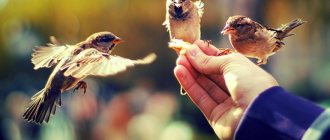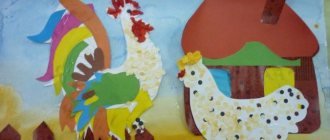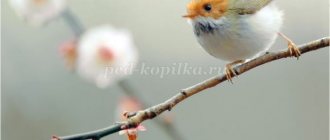Migratory birds
Nabytnova Alla Vasilievna teacher of State Budgetary Educational Institution No. 85 “Bee” Saint Petersburg
MIGRATION BIRDS summary of an integrated lesson in the preparatory group
Target:
Creating conditions for the formation and consolidation of preschool children’s knowledge about migratory birds and their characteristics.
Tasks:
- Continue to introduce children to migratory birds. Find out why they fly away, and which birds fly away first.
- Identify the structural features of different types of birds (beak, paws)
- To develop the ability to draw conclusions during experimental activities.
- Activate the ability to use nouns, verbs, and adjectives in speech.
- Develop word formation skills.
Advertising message
Preliminary work:
- Conversation about migratory birds
- Looking at illustrations
- Reading stories and poems
- Bird watching
- Outdoor and didactic games
Equipment: presentation with slides, demonstration pictures “Migratory Birds”, sound recording “Voices of Birds”, ball, game cube, jar of fat, basin of water.
Greetings.
Good morning, we are glad to see you. Let everything that concerns us be good! Let's hold hands together And we will smile at the guests!
Progress of the lesson.
Organizing time.
To the teacher : I want to read you one very interesting poem by Alexander Izmailov, “Birds Rise to Wing”
The birds took to their wings and began to shout in the gloomy sky To a distant land, where it was warm, They flew in a long flock. “It’s getting cold,” the birds say with a cry. -We're not flying forever. -We'll be back, we promise. - Goodbye, dear land: - We're flying away! Let's fly away! Behind the veil of heaven, birds melt in the gray sky.
Educator: What do you guys think, what time of year does the author describe? Where do the birds fly? Why do you think so? (prove)
Children: About autumn, birds fly south (to warm countries)
Educator: Correct! I suggest you head into the autumn forest and say goodbye to the birds. (slide “Autumn Forest”)
- Conversation.
Educator: Guys, look around, what a beauty it is. What is shown on the screen? Answers
Educator: What time of year? What signs of autumn do you know?
Children: Children's answers.
Educator: Tell me, why do birds fly away in the fall?
Children: They answer.
Educator. Right. And the most important reason is that they have nothing to eat.
Educator. Does anyone know which birds fly away first?
Children: Children's answers.
Educator : Well done, such birds are called insectivores. Their beak is straight, elongated or pointed to make it easier to catch insects. Let's take a look at these birds. (Slide 2. Wagtail, swallow, lark, thrush, cuckoo, nightingale)
Then the birds set off, feeding on plant seeds and fruits. They are called granivores. Let's see who it is. (Slide 3. Chaffinch, siskin, oatmeal)
Let's think about why they fly away second?
Children: the harvest has been harvested. The berries and seeds were covered with the first snow.
Educator: Waterfowl are the last to leave us. Name what waterfowl you know. (On screen: goose, duck, swan).
Children: Answers.
Educator: What is the main feature in the body structure of waterfowl?
Children: Waterfowl have webbed feet. To swim faster.
Educator : Well done. How much do you know? Let's relax with you.
Physical education moment. In the morning the gander stood up on his paws
In the morning the gander stood up on his paws, (Stretched, arms up - inhale and exhale.) Prepared for exercise. (Jerks of arms in front of the chest) Turned left, right, (Turns left and right) Did the squat correctly, (Squats.) Cleaned the fluff with the beak, (Tilts the head left and right) Quickly into the water - splash! (Sit down.)
Educator: Well done. Guys, why do waterfowl get away with it?
Children: Answers. The feathers of waterfowl are covered with fat.
Experience.
Let's check this with you and conduct an experiment with water and fat. (the teacher smears the duck with fat, puts it in the water for a few seconds, then takes it out and the children draw conclusions).
Educator: What happened? How does water drain from your hands? It turned into droplet balls that rolled off your hands. The same thing happens with water on the feathers of waterfowl. Bird feathers are covered with a thin layer of fat, so water drains easily.
Educator : (Slide: forest). Guys, have you noticed that you can’t see or hear any birds in the forest? Maybe something happened? Let's sit quietly. It seems that someone is coming towards us.
An old forest man appears on the screen.
Lesovichok: Hello, guys! Oh, you know what trouble we have in the forest! Baba Yaga bewitched all the birds. She said that if there are brave souls and smart people, she will spell the birds back. But where can I find such people in the forest?
Educator : Guys, what should we do? Shall we help? Don’t be sad, Old Forest Man, our guys will be happy to help you disenchant the birds.
Lesovichok : That's great! Baba Yaga left the first task to be completed.
Word game "Count and name"
Rules of the game: the teacher hands out pictures of migratory birds to the children, asks them to look at them and name them. Then the children are asked to take turns throwing a cube with numbers written on the sides and make up sentences (following the example) using the bird and the number that appears on the cube. For example, “I have two storks”, “I have five rooks”. We find an envelope with trees.
Breathing exercises: “Feather”
Educator: Guys, look, the birds dropped their feathers. We need to put these feathers in the nest. Let's put a feather on our palm. Let's take a deep breath through our nose and blow the feather from our palm, exhaling the air completely, carefully so that the feather falls into the nest. (We find the envelope with the second task).
Educator: Let's read the second task.
Exercise “Say in one word”
The stork has long legs, what is it like? ... (long-legged). The stork has a long beak, it... (long-beaked). The swallow has a long tail, it ... (long-tailed). The swallow loves warmth, she... (heat-loving). The swallow has sharp wings, it... (sharp-winged). The nightingale has a ringing voice, he... (clear-voiced). (We find a cloud, a lake and the sun) and an envelope under No. 3.
Educator: Guys, how many tasks have we completed already? What a great fellow you are. Reading the third task?
Game "Birds are mixed up"
Baba Yaga mixed up all the birds. We need to figure out which birds should
fly away first.
Pictures with birds, plates with painted insects, grains, and a lake. Children look at the birds, highlight their characteristic features and place them on the appropriate plates.
Baba Yaga not only mixed up the birds, she also scattered words with the names of the birds. Let's help collect!
Game "The Word Scattered".
The word scattered like seeds in a garden bed. Make up words Help guys. (Find birds)
Lesovichok: Well done!! There is one last task left. Fourth. Baba Yaga stole fragments from the painting. We need to help restore it and repaint it. Can you handle it?
Children: Yes.
Educator: In order for us to do everything carefully, we need to stretch our fingers .
Finger gymnastics.
Flight.
One, two, three The nightingales fly away. And behind them two rooks fly away screaming. We overtook three starlings. We waved goodbye, We'll be back. We promise!
Educator: Well, we stretched our fingers. Now you can begin the last task.
They do the work, apply glue to the fragments of the picture and glue them on. Afterwards, towards the end of the work, an audio recording of “Birdsong” sounds
Lesovichok: Thank you very much guys for your help! The birds will now fly away for the winter. And for your help, the birds gave you a treat. Goodbye!
Lesson reflection.
Educator: What birds did we talk about? What new have you learned about migratory birds? What tasks did you perform? What did you like?
Progress of the lesson:
1. The teacher reads a poem by A. Pleshcheev:
Boring picture! The clouds are endless, The rain keeps pouring down, Puddles by the porch,
Stunted rowan gets wet under the window; The village looks like a gray blur.
Why are you visiting us early, Autumn? The heart also asks for Light and warmth.
Guys, please tell me what time of year the poem is talking about? /About autumn/
Please name the characteristic signs of autumn? /The foliage turns yellow, it drizzles, the birds fly away/. —What are the names of the birds that fly to warmer regions and those that stay? /Migratory and wintering/. - Name the migratory birds? /Swallow, woodpecker, rook, heron, crane, starling, lark/. — Please guess the riddles:
1. This bird never builds nests for chicks. /Cuckoo/
Please listen to the cuckoo cry. /audio recording/. Guess the next riddle.
2. Under the roof I make a nest out of lumps of clay. For the chicks I put a downy feather bed on the bottom. /Swallow/ /audio recording starts/
3. This is an old friend of ours: He lives on the roof of the house - Long-legged, long-nosed, Long-necked, voiceless. He flies to the swamp to hunt for frogs. /Stork/ /audio recording/
You guessed right, these birds are also migratory. The nightingale is a small bird with brown plumage, a small beak, tail and legs. The cuckoo is a small bird, but larger than the nightingale, has a variegated color, a long tail, and a small beak. The cuckoo, unlike other birds, never makes nests, but lays its eggs in other people's nests, so the birds are forced to hatch and raise cuckoo chicks. The stork is a large white bird with a large beak. — Please name the body parts of birds. /torso, head, tail, beak/. - All birds have the same structure, but people call them differently, how do they distinguish them? /By plumage, appearance, size/ - Guys, why do birds fly to warmer climes? /Because it gets cold here, there are no insects in winter/. - How do they find their way to the south and back here? /we don’t know/. It turns out that some birds fly away at night, others during the day. But before the flight, they make test flights, eat more than usual, put on fat - there is nowhere for them to eat during the flight. In flight, they are guided by the stars, and if the sky is overcast and the stars are not visible, then they are guided by the magnetic oscillations of the Earth. Have you noticed that some birds fly away in “flocks”, all together; some, for example, cranes, line up in a “wedge” in the form of a triangle; others line up in a “chain”, in one line. It probably depends on the habits of the birds: some birds need leaders who show the way.
Physical exercise “Birds”
/fingers of both hands bend/
Sing along, sing along, Ten birds are a flock, This bird is a sparrow, This bird is an owl, A sleepy little head. This bird is a waxwing, This bird is a corncrake, This bird is a starling, A gray feather. This one is a finch, This one is a swift, This one is a cheerful siskin. Well, this one is an angry eagle, Birds, birds, go home. /hands behind back/
Exercise “Guess and sit down”
Guys, now I will name migratory and wintering birds, if you hear the name of a wintering bird, then sit down; and if the name is migratory, then wave your hands. Crow, nightingale, woodpecker, magpie, dove, swallow, tit, rook, starling, bullfinch, stork, crane, sparrow, heron, etc.
Exercise “Say in one word”
Guys, please stand in a circle. I will throw the ball to you, and you will return it to me with an answer.
The stork has long legs, what is it like? ... /long-legged/. The stork has a long beak, it is... /long-billed/. The swallow has a long tail, it is... /long-tailed/. The swallow loves warmth, she is ... /heat-loving/. The swallow has sharp wings, it is... /sharp-winged/. The nightingale has a ringing voice, he... /clear-voiced/.etc.
Exercise “Continue the sentence, find the reason”
Birds that feed on insects are the first to fly south in the fall, because... /insects are hiding and they have nothing to eat/. The woodpecker can be called a forest doctor because .../he takes out bugs and insects from under the bark/. The cuckoo does not hatch its chicks because .../it does not build its own nests/. All people love to listen to the nightingale, because .../he sings beautifully, bursts into song/. etc. In the spring, migratory birds fly back because... /they need to hatch their chicks/.



